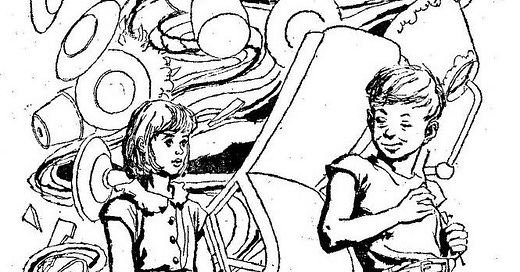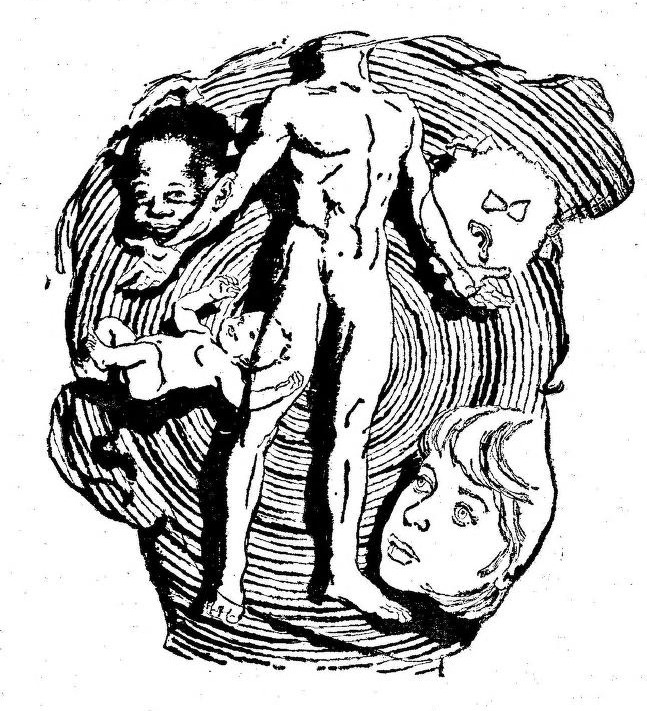Greetings and salutations! I am trying to pound out a lot of newsletter content this month so that I have more of a platform to promote the bookselling side of William Emmons Books. Today I have a review of More Than Human by Theodore Sturgeon considering the novel as a gestalt of its constituent parts which we’ll see is appropriate on a couple levels.
But before we get to Sturgeon, I want to propagandize those of my readers based in the US to buy books and magazines from me.
Shop William Emmons Books
I have two great deals going right now:
Now through Friday (December 6, 2024), I am offering a 10% rebate on all eBay purchases made by subscribers to this newsletter. Just let me know you’re a subscriber after you make a purchase and I’ll remit 10% of the total purchase price back to you.
Now through Christmas Day, I am offering curated bundles of six vintage science fiction and fantasy paperbacks shipped for $25. To take advantage of this deal, contact me directly by replying to this email, emailing me here, or pressing the blue button below. Payment is via Venmo, Cash App, or PayPal. These ship USPS media mail so to ensure arrival before Christmas get your order in by December 14.
More Than Human by Theodore Sturgeon
The book under review is ostensibly a 1953 novel. More properly I think it is three related novellas. The first two parts of More Than Human could easily stand alone. Indeed, the second part debuted as a novella published on its own in the October 1952 issue of Galaxy Science Fiction under the title Baby Is Three. I took in the whole of More Than Human as the 2009 Blackstone audiobook narrated by Stefan Rudnicki and Harlan Ellison.
Baby Is Three is well remembered as one of the best novellas of 1950s American science fiction. This artistic success begs the question, “Why pad it out?” There’s a danger of mangling something special. Of course, the answer is that markets often get what markets want and that what the then-burgeoning science fiction book market wanted was novels.
With the whole novel under my belt and knowledge of the publication history in hand, the first and third parts seem to lack a certain verve and originality present in the second part. In the first and third parts, Sturgeon is mainly expanding on concepts already present in Baby Is Three.
Of course, going into the first part, you wouldn’t know he’s simply filling out back story unless you had previously read Baby Is Three. Coming in without that background—a background I suspect most other readers of More Than Human have also lacked—the first part, subtitled The Fabulous Idiot, hits like a ton of bricks.
I usually husband out audiobooks so that I’m listening to around one hour of a given book a day. This lets me listen to multiple audiobooks at a time. With this one, I listened to closer to three hours in my first sitting and found myself reciting the plot of The Fabulous Idiot to my partner to make sure I hadn’t hallucinated it. If that’s the power of something that’s basically derivative of Baby Is Three, there’s obviously juice to spare in the original.
Whoever masterminded the audiobook seems to have recognized the raw power of Baby Is Three vis-à-vis the other parts of this novel. This is reflected in the choice of narrators. The first and third parts are narrated by Stefan Rudnicki, a master narrator to be sure but also a standard choice for audiobooks of American science fiction classics. The second part is narrated by the late bipolar science fiction rock star Harlan Ellison. I haven’t engaged deeply with Ellison’s work but I recognize what his name and personality represent to people and that it’s not for nothing that he’s only narrating a choice cut of the book.
To the plot! The Fabulous Idiot is about a teen boy simply called the Idiot (until he is given the name Lone) who can’t speak (until he learns how) and who has extreme psi powers. He can understand the telepathic sendings of babies (all babies are telepathic until they aren’t), read minds, and make anyone do or think anything through a facility he doesn’t seem to fully understand until later. He has an early tryst with another young telepath that turns traumatic when the other telepath’s ultraconservative father kills her for their heavy petting. The Idiot responds by using his psi powers to induce the father to kill himself.
The story builds up from there and involves other youngsters with a variety of psi powers. All of them end up on their own living in the woods and form a group organism later dubbed homo gestalt. This new species of collective superman is the central conceit of the novel. The Idiot forms the head of homo gestalt which turns out to be sort of a bummer for its other constituent parts because he is after all an idiot.
Most of the parts of homo gestalt are disabled or ill in some way. The brain is a dwarf child with Down syndrome called Baby who is basically a supercomputer whose communication is limited to a complex sign language understood by only one other member of the organism. Then there’s Bonnie and Beanie, a pair of Black twin girls who constitute the organism’s hands because they have the power to teleport and who are mute. Even Gerry, the intellectual giant who replaces the Idiot upon his untimely demise, is compared to a person with bipolar disorder.
The structure of Baby Is Three is a 15 year old Gerry going to psychotherapy. He is interrogating whether or not he was justified in murdering a maternal figure who was kind to the constituent parts of homo gestalt but whose approach to being a foster parent had the effect of isolating those parts and threatening the existence of the new species. Is it possible for a new superman species to have a morality when it is the first and only one of its kind?
Sturgeon draws uncanny energy from his outcast, disabled, and otherwise strange cast of characters and then says these people represent the next phase of genus homo. Yet there remains something unsavory with Sturgeon’s use of unspeaking Black girls and a dwarf Down syndrome child all of whom have no interiority the reader is able to access. These characters are mere body parts sublated into homo gestalt who can only hope to be understood through Janie, a relatively normal if telekinetic white girl who serves as the organism’s mouth.
This is all stewed in an apparently earnest belief in Dianetics and Campbellian psi nonsense. Despite its flaws and origins, I was unable to pull myself away from the first two parts. The Fabulous Idiot and Baby Is Three have a general atmosphere of strangeness in which kids have to be ratchet to survive outside a society that has basically abandoned them. The effect is jarring and elemental.
The third part, subtitled Morality, tries to give a practical solution to the question about morality posed by the second. Yet Baby Is Three was complete without the question being answered so I wonder whether the third part was necessary for More Than Human to congeal.
My advice for the reader of science fiction classics on the go is to just read Baby Is Three. If you’re a completist with too much time on your hands, take a crack at More Than Human.






More than Human was the first Sturgeon I read. The power of the first section remains in my mind -- although most of the details have faded. My appreciation for Sturgeon has grown in subsequent years as I've read more and more of his short fiction. I really should return to this one!